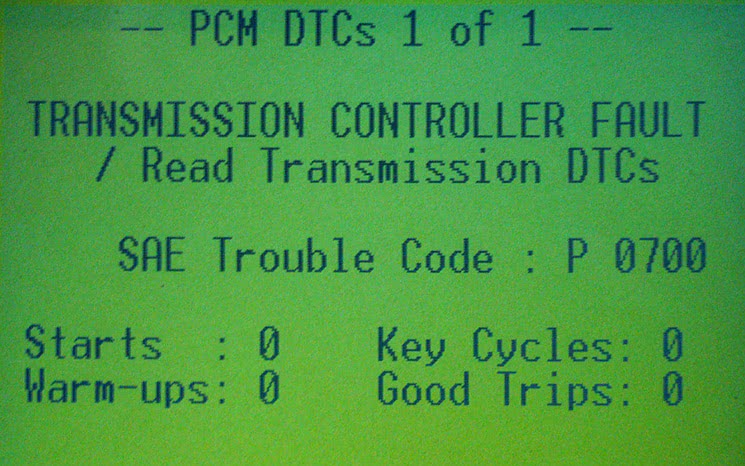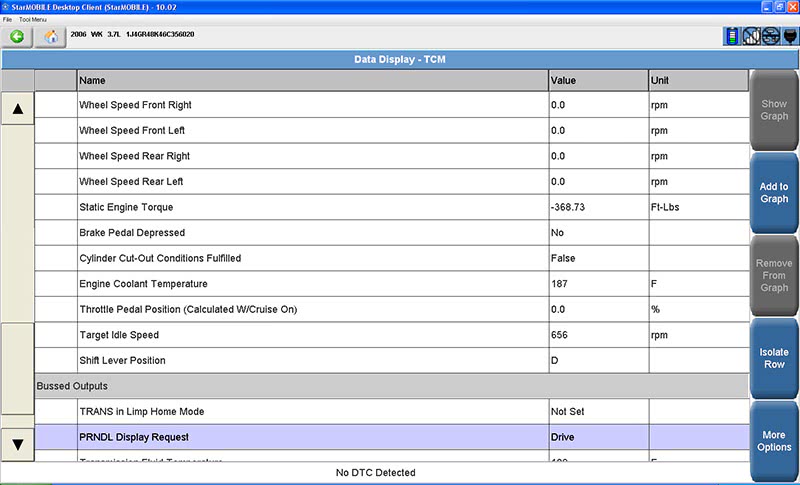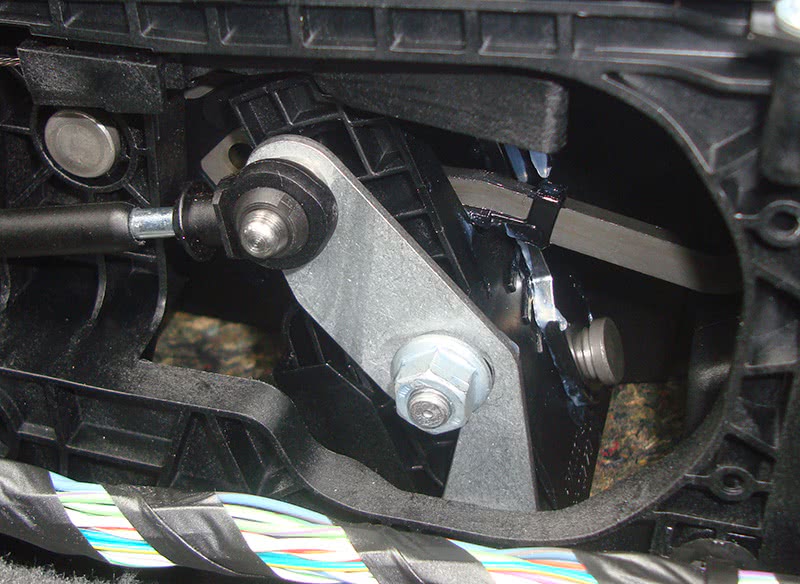by Kerry Jonsson

We started by pulling codes with our DRB III. We were only able to access the PCM, and found a P0700. This gave us some hope. A DTC in the transmission may give us some concrete evidence that may lead us to the cause of the problem.
In your neck of the woods, things may be different. Where we are, we have automotive repair shops and transmission rebuilders. Although some of the large trans franchises are moving into general auto service, for the most part we’re still split. The 2006 Jeep Grand Cherokee that’s our subject here came from one of those transmission shops. They were doing the honorable thing. We specialize in diagnostics, and they specialize in rebuilding. The vehicle was brought to them because the owner felt the problem was related to the transmission. The vehicle would go into neutral intermittently while driving. The owner would pull over and shut the car off, restart it, put it in gear and resume driving. While this isn’t the classic symptom of a slipping transmission that goes nowhere when you step on the gas, it could still be construed as a transmission-related problem
Â
Since the problem was intermittent, it was going to be difficult to experience it and hard to test for it. A little knowledge, however, goes a long way. We were going to need to know two things to finger the culprit. Number one, have any of the computers picked up a self-diagnostic trouble code that may lead us to the cause? And, number two, how is the system laid out? On many Ford systems, the PCM controls the transmission, whereas other manufacturers have a separate Transmission Control Module (TCM) calling the shots. What computers do I have to have access to get this information? The StarMobile is the factory scan tool for this vehicle. We tried using our DRB III, but only pulled a P0700, which meant there was a code in the TCM.
In this Grand Cherokee, the TCM is mounted in the PCM, or they are simply one unit. However, from the scan tool’s perspective you need to select PCM to retrieve engine codes and TCM to get transmission-related codes. Our DRB III could get into the engine, but could not get into the transmission. To get into the TCM for data, we were going to need a StarMobile, which is the factory scan tool from Chrysler. You may have an aftermarket equivalent that will access these systems. As long and you can pull the codes/data and they’re accurate, you are okay. We looked in the TCM and only saw one code: U0404. The definition is “Implausible Data Received from ESM.†ESM! What the heck is an ESM? More importantly, can it cause this symptom? How am I going to test it?

We needed to use our StarMobile scan tool to access the TCM, although your aftermarket scan tool may work. We got communication code U0404, which means there are problems with data from the ESM.
Â
Both Mitchell and Alldata provide Bus Communication wiring diagrams that will show you which control units are on the bus. These units communicate on a Controller Area Network (CAN), with a CAN-high signal and a CAN-low signal. The high signal starts close to ground and the square wave goes up to approximately 2.5 volts. The low signal starts at around 5.0 volts and drops to about 2.5 volts. These two signal wires mirror each other. Following the CAN wires in our diagram shows all the different control units that are connected. We needed to look for an ESM. After sifting through the wiring for the automatic transmission, we saw an “Assembly Shift Lever.†This is also known as the Electronic Shifter Module (ESM) in Mercedes-Benz speak. Since Daimler bought Chrysler, it integrated some of its systems into newer model Jeeps.

Even though the ESM may have put out some bad data, our scan tool could communicate with it. Our problem is intermittent, so it may not be present now. Very often, the problem control unit will not have communication codes, but another computer will.
Â
Mercedes-Benz uses an ESM to determine what gear position the driver has selected. It is not just a switch assembly that sends inputs into a TCM, but it is its own control unit. It communicates the gear position through the CAN network. This makes it difficult to test the unit without scan tool access to the ESM. Looking at scan data would be the fastest way to determine if it’s working. You can use an oscilloscope to make sure the square wave signals are not shorted to another power source or ground, but you will not be able to interpret the actual software communication. Check your scan tool to see if you have communication with the PCM, TCM (even though they are in the same unit), and ESM. Check for codes in each system and look at any data PIDs, especially ones dealing with gear position.

A look at the scan data shows the highlighted PRNDL PID under Bussed Outputs, indicating that we’re in Drive. Two PIDs above Shift Lever Position also indicate Drive. This is a bussed input from the ESM, and at the moment it’s functioning.
Â

To remove the shifter, you have to remove the key interlock cable. There is no adjustment on this cable. Simply unclip the housing mount and thread the cable through its holder.
When looking for communication codes, don’t necessarily look in the ESM and expect to find an internal failure. It could happen and that would be the smoking gun. You may attempt to communicate and if you can’t, check powers and grounds to the control unit and scope the CAN lines to make sure you don’t have a wiring problem. If everything is okay, you probably have a bad control unit. This is not true in every case. If we had a failed control unit the symptoms of the problem would always be present. In this case, we always had communication with the ESM through our StarMobile. Also, the vehicle only went into neutral intermittently. In many instances, the problem control unit will not have any communication DTCs. Look in other control units for communication codes. The control units that rely on information from the ESM should flag codes when communication is lost.

When installing the shifter, put it in park. Pull on the shift cable all the way rearward, then position the lever so you can pop the ball socket on the lever. Then tighten the 13mm nut to secure the adjustment.
We know the PCM had a P0700 and we did not find any codes in the ESM. We looked in the TCM and found the code P0404, which is essentially loss of communication with the ESM, but we had communication now. It is possible the loss of communication with the ESM caused the TCM to put the transmission into neutral. Being an intermittent problem this would be hard to prove conclusively. We decided to look into data to see if any clues would jump out at us. The TCM is the only control unit that can put the transmission into neutral, so we decided to look there first. The data is grouped into three sections. There are direct inputs, bussed in inputs, and bussed outputs. Look at the TCM wiring diagram and you will see the direct inputs such as gear pressure switches and fluid temperature.
Bussed inputs such as engine load, vehicle speed, and shift lever position come in from other control units. Engine load comes from the MAF sensor reading in the PCM. Vehicle speed comes in from the ABS and traction control systems. Shift lever position comes in from the ESM (or Assembly-Shift Lever, as worded in the wiring diagram). A bussed output would be information put out by the TCM. This includes the shifter position. Looking at figure #3, you can see that the TCM can put out even if the limp-home mode is activated. When looking at data, we noticed the shifter position was in both the bussed input and outputs. As we moved the selector lever through the various gear positions, we saw the change in data. At the moment everything was working fine. Having nothing else to go on we decided to inform the customer where we were and that we believed the problem was in the ESM.
After looking at the cost of the part and the cost of labor to drive around and wait for an intermittent problem, the customer opted for the new ESM module. The job involves the removal of the center console; not too time consuming. There is a single electrical connection for the power, ground, illumination, brake switch, manual shift controls and CAN connections. The shifter has mechanical connections with two cables. The upper, smaller cable is for the key interlock so that you can’t remove the key from the ignition unless the shifter is in park. The other cable is connected to the transmission mechanical shift input. This allows for failsafe operation of park, reverse, neutral, and drive, in the event of electrical failure. The key interlock cable has two clips that when squeezed together unlock the cable housing and allow it to be removed. Then unhook the ball end of the cable from the shifter assembly.
The shifter cable just slides out, and the ball socket has to be popped off before you can totally remove the shifter. When installing the new shifter, the lever in the assembly is not locked down. A 13mm nut must be tightened when both the shifter cable and shifter lever are in the correct position. To make sure of this, pull the cable all the way toward the back of the vehicle. This insures the transmission is in the park position. The driveshaft should not rotate when you try to turn it. With the shifter in Park, adjust the lever in the shifter until the ball on the lever can be attached to the ball socket of the cable. At this point tighten down the 13mm nut and the shifter and cable will be properly adjusted. Reassemble the center console and go for a test drive to verify that you can catch all the gear positions.
If you have the opportunity drive the vehicle with the scan tool connected, you can watch the gear position in both bussed input and output PIDs. You may get lucky and catch the problem when it happens. With this vehicle, the ESM did indeed fix the problem. After several days, the customer called back and let us know the transmission was now staying in gear. By looking at the DTCs and the data, we actually found the fault in the TCM, which led us to replace the ESM and resolve the issue. We now know that loss of communication or incorrect data from the ESM can cause the transmission to go into neutral. We checked the system electrically as best we could. It would have been more conclusive to drive the vehicle until the problem occurred, but sometimes we have to work within time limits. That’s life, and this time it worked out okay.




0 Comments